Are Urban Green Spaces’ Attributes Relevant to Explain the Occurrence of Invasive Species Within Urban Green Infrastructure?
Abstract
1. Introduction
2. Materials and Methods
3. Results
3.1. Characterization of Urban Green Infrastructure
3.1.1. Types, Size, and Geometry of Urban Green Spaces
3.1.2. Urban Green Spaces by Access to Users
3.1.3. Maintenance Level of Urban Green Spaces
3.2. Invasive Plant Species in Urban Green Infrastructure
Chi-Square Test
4. Discussion
5. Conclusions
Supplementary Materials
Author Contributions
Funding
Data Availability Statement
Acknowledgments
Conflicts of Interest
Abbreviations
| ESs | Ecosystem Services |
| EDs | Ecosystem Disservices |
| UGI | Urban Green Infrastructure |
| UGSs | Urban Green Spaces |
References
- European Union. Report from the Commission to the European Parliament, the Council, the European Economic and Social Committee and the Committee of the Regions. Review of Progress on Implementation of the EU Green Infrastructure Strategy 2019. Available online: https://eur-lex.europa.eu/legal-content/EN/TXT/PDF/?uri=CELEX:52019DC0236&qid=1562053537296&from=EN (accessed on 11 November 2024).
- Hasen, R.; Pauleit, S. From Multifunctionality to Multiple Ecosystem Services? A Conceptual Framework for Multifunctionality in Green Infrastructure Planning for Urban Areas. AMBIO 2014, 43, 516–529. [Google Scholar] [CrossRef] [PubMed]
- Ahern, J. Green Infrastructure for Cities: The Spatial Dimension; University of Massachusetts: Amherst, MA, USA, 2007. [Google Scholar]
- Mell, I. Can green infrastructure promote urban sustainability? Proc. Inst. Civ. Eng.-Eng. Sustain. 2009, 162, 23–34. [Google Scholar] [CrossRef]
- Gill, S.; Handley, J.F.; Ennos, R.; Pauleit, S. Adapting Cities for Climate Change: The Role of the Green Infrastructure. Built Environ. 2007, 33, 115–133. [Google Scholar] [CrossRef]
- Demuzere, M.; Orru, K.; Heidrich, O.; Olazabal, E.; Geneletti, D.; Orru, H.; Bhave, A.G.; Mittal, N.; Feliu, E.; Faehnle, M. Mitigating and adapting to climate change: Multi-functional and multi-scale assessment of green urban infrastructure. J. Environ. Manag. 2014, 146, 107–115. [Google Scholar] [CrossRef]
- Jones, S.; Somper, C. The role of green infrastructure in climate change adaptation in London. Geogr. J. 2014, 180, 191–196. [Google Scholar] [CrossRef]
- Lindley, S.J.; Gill, S.E.; Cavan, G.; Yeshitela, K.; Nebebe, A.; Woldegerima, T.; Kibassa, D.; Shemdoe, R.; Renner, F.; Buchta, K.; et al. Green Infrastructure for Climate Adaptation in African Cities. In Urban Vulnerability and Climate Change in Africa: A Multidisciplinary Approach; Pauleit, S., Coly, A., Fohlmeister, S., Gasparini, P., Jørgensen, G., Kabisch, S., Kombe, W.J., Lindley, S., Simonis, I., Yeshitela, K., Eds.; Springer International Publishing: Berlin/Heidelberg, Germany, 2015; pp. 107–152. [Google Scholar]
- Carter, J.G.; Handley, J.; Butlin, T.; Gill, S. Adapting cities to climate change—Exploring the flood risk management role of green infrastructure landscapes. J. Environ. Plan. Manag. 2018, 61, 1535–1552. [Google Scholar] [CrossRef]
- Belčáková, I.; Świąder, M.; Bartyna-Zielińska, M. The Green Infrastructure in Cities as A Tool for Climate Change Adaptation and Mitigation: Slovakian and Polish Experiences. Atmosphere 2019, 10, 552. [Google Scholar] [CrossRef]
- De la Sota, C.; Ruffato-Ferreira, V.J.; Ruiz-García, L.; Alvarez, S. Urban green infrastructure as a strategy of climate change mitigation. A case study in northern Spain. Urban For. Urban Green 2019, 40, 145–151. [Google Scholar] [CrossRef]
- Sturiale, L.; Scuderi, A. The Role of Green Infrastructures in Urban Planning for Climate Change Adaptation. Climate 2019, 7, 119. [Google Scholar] [CrossRef]
- Locatelli, L.; Guerrero, M.; Russo, B.; Martínez-Gomariz, E.; Sunyer, D.; Martínez, M. Socio-Economic Assessment of Green Infrastructure for Climate Change Adaptation in the Context of Urban Drainage Planning. Sustainability 2020, 12, 3792. [Google Scholar] [CrossRef]
- Ramyar, R.; Ackerman, A.; Johnston, D.M. Adapting cities for climate change through urban green infrastructure planning. Cities 2021, 117, 103316. [Google Scholar] [CrossRef]
- Mumtaz, M. Green infrastructure as key tool for climate adaptation planning and policies to mitigate climate change: Evidence from a Pakistani City. Urban Clim. 2024, 56, 102074. [Google Scholar] [CrossRef]
- Tzoulas, K.; Korpela, K.; Venn, S.; Yli-Pelkonen, V.; Kaźmierczak, A.; Niemela, J.; James, P. Promoting ecosystem and human health in urban areas using Green Infrastructure: A literature review. Landsc. Urban Plan. 2007, 81, 167–178. [Google Scholar] [CrossRef]
- Haase, D.; Larondelle, N.; Andersson, E.; Artmann, M.; Borgström, S.; Breuste, J.; Gomez-Baggethun, E.; Gren, Å.; Hamstead, Z.; Hansen, R.; et al. A Quantitative Review of Urban Ecosystem Service Assessments: Concepts, Models, and Implementation. AMBIO 2014, 43, 413–433. [Google Scholar] [CrossRef]
- Filazzola, A.; Shrestha, N.; MacIvor, J.S. The contribution of constructed green infrastructure to urban biodiversity: A synthesis and meta-analysis. J. Appl. Ecol. 2019, 56, 2131–2143. [Google Scholar] [CrossRef]
- Farkas, J.Z.; Hoyk, E.; Batista de Morais, M.; Csomós, G. A systematic review of urban green space research over the last 30 years: A bibliometric analysis. Heliyon 2023, 9, e13406. [Google Scholar] [CrossRef]
- Wolch, J.R.; Byrne, J.; Newell, J.P. Urban green space, public health, and environmental justice: The challenge of making cities‘just green enough’. Landsc. Urban Planning 2014, 125, 234–244. [Google Scholar] [CrossRef]
- Eldridge, D.J.; Cui, H.; Ding, J.; Berdugo, M.; Sáez-Sandino, T.; Duran, J.; Gaitan, J.; Blanco-Pastor, J.L.; Rodríguez, A.; Plaza, C.; et al. Urban greenspaces and nearby natural areas support similar levels of soil ecosystem services. Urban Sustain. 2024, 4, 15. [Google Scholar] [CrossRef]
- Getter, K.L.; Rowe, D.B. The Role of Extensive Green Roofs in Sustainable Development. HortScience 2006, 41, 1276–1285. [Google Scholar] [CrossRef]
- Langemeyer, J.; Wedgwood, D.; McPhearson, T.; Baró, F.; Madsen, A.L.; Barton, D.N. Creating urban green infrastructure where it is needed—A spatial ecosystem service-based decision analysis of green roofs in Barcelona. Sci. Total Environ. 2020, 707. [Google Scholar] [CrossRef]
- Nowak, D.J.; Hirabayashi, S.; Bodine, A.; Greenfield, E. Tree and forest effects on air quality and human health in the United States. Environ. Pollut. 2014, 193, 119–129. [Google Scholar] [CrossRef]
- Richards, D.R.; Edwards, P.J. Quantifying street tree regulating ecosystem services using Google Street View. Ecol. Indic. 2017, 77, 31–40. [Google Scholar] [CrossRef]
- Tan, X.; Hirabayashi, S.; Shibata, S. Estimation of Ecosystem Services Provided by Street Trees in Kyoto, Japan. Forests 2021, 12, 311. [Google Scholar] [CrossRef]
- Berglihn, E.C.; Gómez-Baggethun, E. Ecosystem services from urban forests: The case of Oslomarka, Norway. Ecosyst. Serv. 2021, 51, 101358. [Google Scholar] [CrossRef]
- Mitchell, M.G.E.; Devisscher, T. Strong relationships between urbanization, landscape structure, and ecosystem service multifunctionality in urban forest fragments. Landsc. Urban Plan. 2022, 228, 104548. [Google Scholar] [CrossRef]
- Sui, Q.; Jia, H.; Zhao, M.; Zhou, Y.; Fan, L. Quantitative Evaluation of Ecosystem Services of Urban Street Trees: A Case Study of Shengjing Historical and Cultural Blockin Shenyang, China. Sustainability 2023, 15, 2532. [Google Scholar] [CrossRef]
- Zhang, M.; He, J.; Liu, D.; Huang, J.; Yue, Q.; Li, Y. Urban green corridor construction considering daily life circles: A case study of Wuhan city, China. Ecol. Eng. 2022, 184, 106786. [Google Scholar] [CrossRef]
- Huang, H.; Qi, J.; Xiao, S.; Wende, W.; Xin, Y. A Reflection on the Implementation of a Water front Greenway from a Social—Ecological Perspective: A Case Study of Huangyan-Taizhou in China. Land 2024, 13, 989. [Google Scholar] [CrossRef]
- Goddard, M.A.; Dougill, A.J.; Benton, T.G. Scaling up from gardens: Biodiversity conservation in urban environments. Trends Ecol. Evol. 2010, 25, 90–98. [Google Scholar] [CrossRef]
- Davies, Z.G.; Edmondson, J.L.; Heinemeyer, A.; Leake, J.R.; Gaston, K.J. Mapping an urban ecosystem service: Quantifying above-ground carbon storage at a city-wide scale. J. Appl. Ecol. 2011, 48, 1125–1134. [Google Scholar] [CrossRef]
- Gascon, M.; Triguero-Mas, M.; Martinez, D.; Dadvand, P.; Forns, J.; Plasència, A.; Nieuwenhuijsen, M. Mental Health Benefits of Long-Term Exposure to Residential Green and Blue Spaces: A Systematic Review. Int. J. Environ. Res. Public Health 2015, 12, 4354–4379. [Google Scholar] [CrossRef] [PubMed]
- Kabisch, N.; Strohbach, M.; Haase, D.; Kronenberg, J. Urban green space availability in European cities. Ecological Indicators. 2016, 70, 586–596. [Google Scholar] [CrossRef]
- Benedict, M.; MacMahon, E. Green Infrastructure: Smart Conservation for the 21st Century. Renew. Resour. J. 2002, 20, 12–17. [Google Scholar]
- McPhearson, T.; Hamstead, Z.A.; Kremer, P. Urban Ecosystem Services for Resilience Planning and Management in New York City. AMBIO 2014, 43, 502–515. [Google Scholar] [CrossRef]
- Lyytimäki, J.; Petersen, L.K.; Normander, B.; Bezák, P. Nature as a nuisance? Ecosystem services and disservices to urban lifestyle. Environ. Sci. 2008, 5, 161–172. [Google Scholar] [CrossRef]
- Mckinney, M. Effects of urbanization on species richness: A review of plants and animals. Urban Ecosyst. 2008, 11, 161–176. [Google Scholar] [CrossRef]
- Kueffer, C. Plant invasions in the Anthropocene. Science 2017, 358, 724–725. [Google Scholar] [CrossRef]
- Stohlgren, T.; Barnett, D.; Kartesz, J. The Rich Get Richer: Patterns of Plant Invasions in the United States. Front. Ecol. Environ. 2003, 1, 11–14. [Google Scholar] [CrossRef]
- Simberloff, D.; Martin, J.-L.; Genovesi, P.; Maris, V.; Wardle, D.A.; Aronson, J.; Courchamp, F.; Galil, B.; García-Berthou, E.; Pascal, M.; et al. Impacts of biological invasions: What’s what and the way forward. Trends Ecol. Evol. 2013, 28, 58–66. [Google Scholar] [CrossRef]
- Andrade, M.; Fernandes, C.; Coutinho, A.; Figueiredo, A. Urban Green Infrastructure: Does Species’ Origin Impair Ecosystem Services Provision? Land 2024, 13, 23. [Google Scholar] [CrossRef]
- Pyšek, P.; Jarošík, V.; Hulme, P.E.; Pergl, J.; Hejda, M.; Schaffner, U.; Vilà, M. A global assessment of invasive plant impacts on resident species, communities and ecosystems: The interaction of impact measures, invading species’ traits and environment. Glob. Chang.Biol. 2012, 18, 1725–1737. [Google Scholar] [CrossRef]
- Nguyen, N.-A.; Eskelson, B.N.I.; Gergel, S.E.; Murray, T. The occurrence of invasive plant species differed significantly across three urban greenspace types of Metro Vancouver, Canada. Urban For. Urban Green. 2021, 59, 126999. [Google Scholar] [CrossRef]
- Štajerová, K.; Šmilauer, P.; Brůna, J.; Pyšek, P. Distribution of invasive plants in urban environment is strongly spatially structured. Landsc. Ecol. 2017, 32, 681–692. [Google Scholar] [CrossRef]
- Szumańska, I.; Lubińska-Mielińska, S.; Kamiński, D.; Rutkowski, L.; Nienartowicz, A.; Piernik, A. Invasive Plant Species Distribution Is Structured by Soil and Habitat Type in the City Landscape. Plants 2021, 10, 773. [Google Scholar] [CrossRef]
- Parendes, L.A.; Jones, J.A. Role of Light Availability and Dispersal in Exotic Plant Invasion along Roads and Streams in the H.J. Andrews Experimental Forest, Oregon. Conserv. Biol. 2000, 14, 64–75. [Google Scholar] [CrossRef]
- D’Antonio, C.M.; Vitousek, P.M. Biological Invasions by Exotic Grasses, the Grass/Fire Cycle, and Global Change. Annu. Rev. Ecol. Evol. Syst. 1992, 23, 63–87. [Google Scholar] [CrossRef]
- Hobbs, R.J.; Higgs, E.; Harris, J.A. Novel ecosystems: Implications for conservation and restoration. Trends Ecol. Evol. 2009, 24, 599–605. [Google Scholar] [CrossRef]
- Hulme, P.E. Climate change and biological invasions: Evidence, expectations, and response options. Biol. Rev. 2017, 92, 1297–1313. [Google Scholar] [CrossRef]
- Teixeira, C.P.; Fernandes, C.O. Novel ecosystems: A review of the concept in non-urban contexts. Landsc. Ecol. 2020, 35, 23–39. [Google Scholar] [CrossRef]
- Copernicus Land Monitoring Service. Imperviousness Density 2018. Available online: https://land.copernicus.eu/en/products/high-resolution-layer-imperviousness/imperviousness-density-2018#general_info (accessed on 4 June 2024).
- Direção Geral doTerritório. Registo Nacional de Dados Geográficos. Available online: https://snig.dgterritorio.gov.pt/rndg/srv/por/catalog.search#/search?resultType=details&sortBy=referenceDateOrd&anysnig=Carta%20de%20Uso%20e%20Ocupação%20do%20Solo%20-%202018&geometry=region:http://id.igeo.pt/so/AU/AdministrativeUnit/Freguesias_060334/2017&fast=index&from=1&to=20 (accessed on 4 June 2024).
- Instituto Nacional de Estatística (INE). Recenseamento da população e habitação–Censos 2021. Available online: https://mapas.ine.pt/download/index2021.phtml (accessed on 4 June 2024).
- Cordeiro, A.M.R. Morphological System and Urban Settlements. Coimbra (Portugal): A City from the Roman Times to thePresent. Cuad. Vivienda Urban. 2021, 14, 1–19. [Google Scholar]
- Calmeiro, M.R. Evolution and Permanence in Coimbra’s Urban Form. The Emergence of Urban Planning in Portugal at theTurn of the Twentieth-Century. In International Planning History Society Proceedings, 19th IPHS Conference, City-Space-Transformation, TU Delft, Delft, The Netherlands, 5–6 July 2022; Hein, G., Ed.; TU Delft Open: Delft, The Netherlands, 2022. [Google Scholar]
- Coimbra Municipal Master Plan. Planta de Ordenamento—Classificação e Qualificação do Solo. Available online: https://www.cm-coimbra.pt/wp-content/uploads/2018/10/Altera%C3%A7%C3%A3o%20por%20Adapta%C3%A7%C3%A3o%20do%20PDM%20-%20Planta%20de%20Ordenamento%20%E2%80%93%20Classifica%C3%A7%C3%A3o%20e%20Qualifica%C3%A7%C3%A3o%20do%20Solo.pdf (accessed on 14 April 2025).
- Farinha-Marques, P.; Fernandes, C.; Lameiras, J.; Silva, S.; Leal, I.; Guilherme, F. Morfologia e Biodiversidade nos EspaçosVerdes da Cidade do Porto—Livro 1: Selecção das areas de Estudo, 2a Edição, Revista e Aumentada; Faculdade de Ciências da Universidade do Porto (FCIP): Porto, Portugal, 2014. [Google Scholar]
- Barchetta, L.; Chiodelli, F. The Variety of Urban Green Spaces and Their Diverse Accessibility; Gran Sasso Science Institute: L’Aquila, Italy, 2015. [Google Scholar]
- ICNF. Lista Nacional de Espécies Invasoras, Conforme Previsto no n.º 1 do Artigo 17.º. Instituto de Conservação da Natureza e das Florestas. Available online: https://www.icnf.pt/api/file/doc/cf455e5a84ab1d96 (accessed on 13 March 2022).
- Jim, C.Y.; Chen, W.Y. Assessing the ecosystem service of air pollutant removal by urban trees in Guangzhou (China). J. Environ. Manag. 2008, 88, 665–676. [Google Scholar] [CrossRef] [PubMed]
- Maes, J.; Zulian, G.; Guenther, S.; Thijssen, M.; Raynal, J. Enhancing Resilience of Urban Ecosystems Through Green Infrastructure (En Route); Publications Office of the European Union: Luxembourg, 2019. [Google Scholar]
- Pearse, W.D.; Cavender-Bares, J.; Hobbie, S.E.; Avolio, M.L.; Bettez, N.; Roy Chowdhury, R.; Darling, L.E.; Groffman, P.M.; Grove, J.M.; Hall, S.J.; et al. Homogenization of plant diversity, composition, and structure in North American urban yards. Ecosphere 2018, 9, e02105. [Google Scholar] [CrossRef]
- Gulezian, P.Z.; Nyberg, D.W. Distribution of invasive plants in a spatially structured urban landscape. Landsc. Urban Plan. 2010, 95, 161–168. [Google Scholar] [CrossRef]
- Ali, S.M.; Malik, R.N. Vegetation communities of urban open spaces: Green belts and parks in Islamabad city. Pak. J. Bot. 2010, 42, 1031–1039. [Google Scholar]
- Branquinho, C.; Cvejić, R.; Eler, K.; Gonzales, P.; Haase, D.; Hansen, R.; Kabischh, N.; Rall, E.L.; Niemela, J.; Pauliet, S.; et al. A Typology of Urban Green Spaces, Ecosystem Services Provisioning Services and Demands. Report D3.1 for the GREEN SURGE Project (2013–2017). 2015. Available online: https://assets.centralparknyc.org/pdfs/institute/p2p-upelp/1.004_Greensurge_A+Typology+of+Urban+Green+Spaces.pdf (accessed on 15 June 2022).
- Deparis, M.; Legay, N.; Isselin-Nondedeu, F.; Bonthoux, S. Considering urban uses at a fine spatial resolution to understandthe distribution of invasive plant species in cities. Landsc. Ecol. 2022, 37, 1145–1159. [Google Scholar] [CrossRef]
- Heywood, V.H. The nature and composition of urban plant diversity in the Mediterranean. Flora Mediter. 2017, 27, 195–220. [Google Scholar]
- Hui, C.; Richardson, D.; Visser, V. Ranking of invasive spread through urban green areas in the world’s 100 most populous cities. Biol. Invasions 2017, 19, 3527–3539. [Google Scholar] [CrossRef]
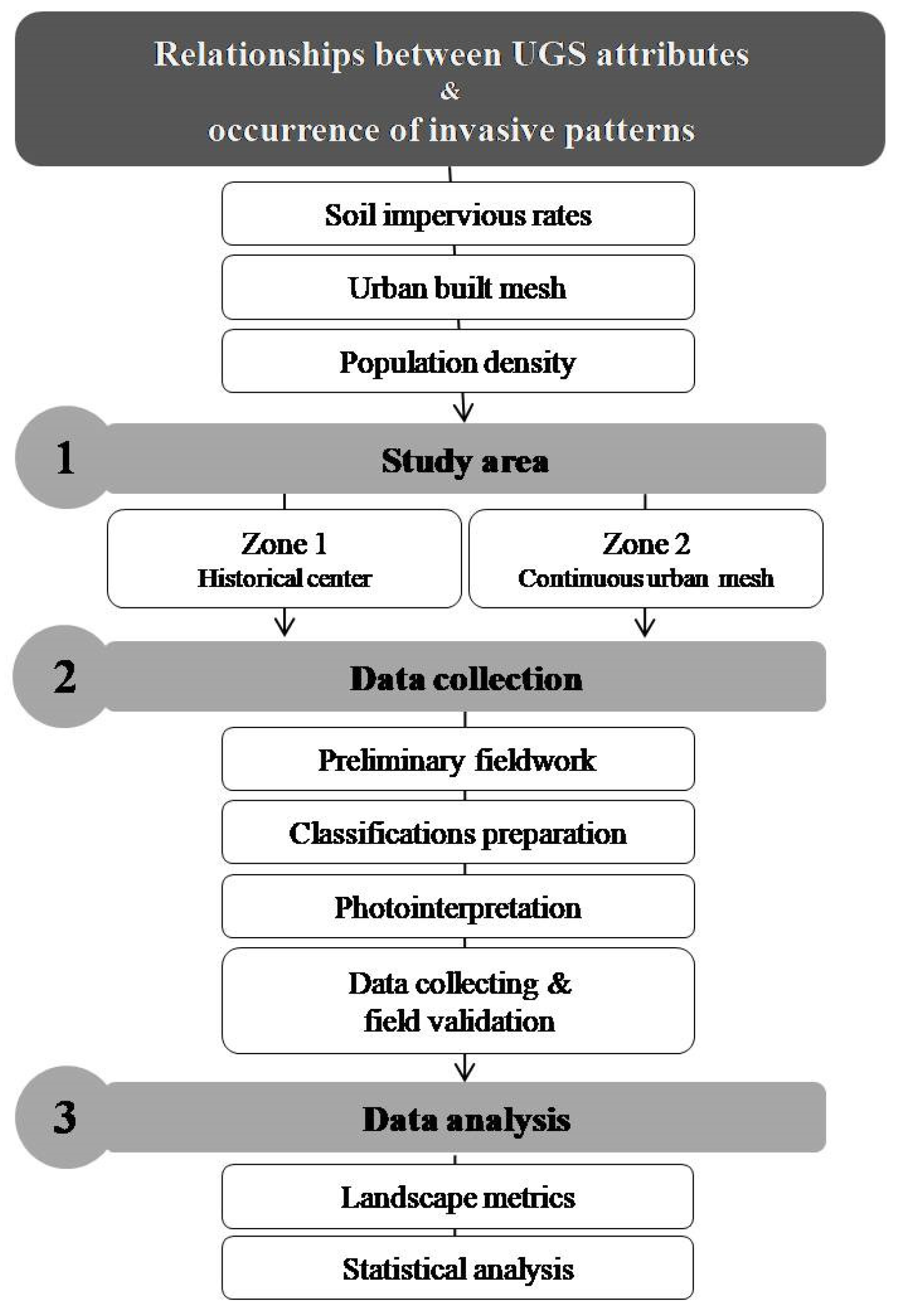
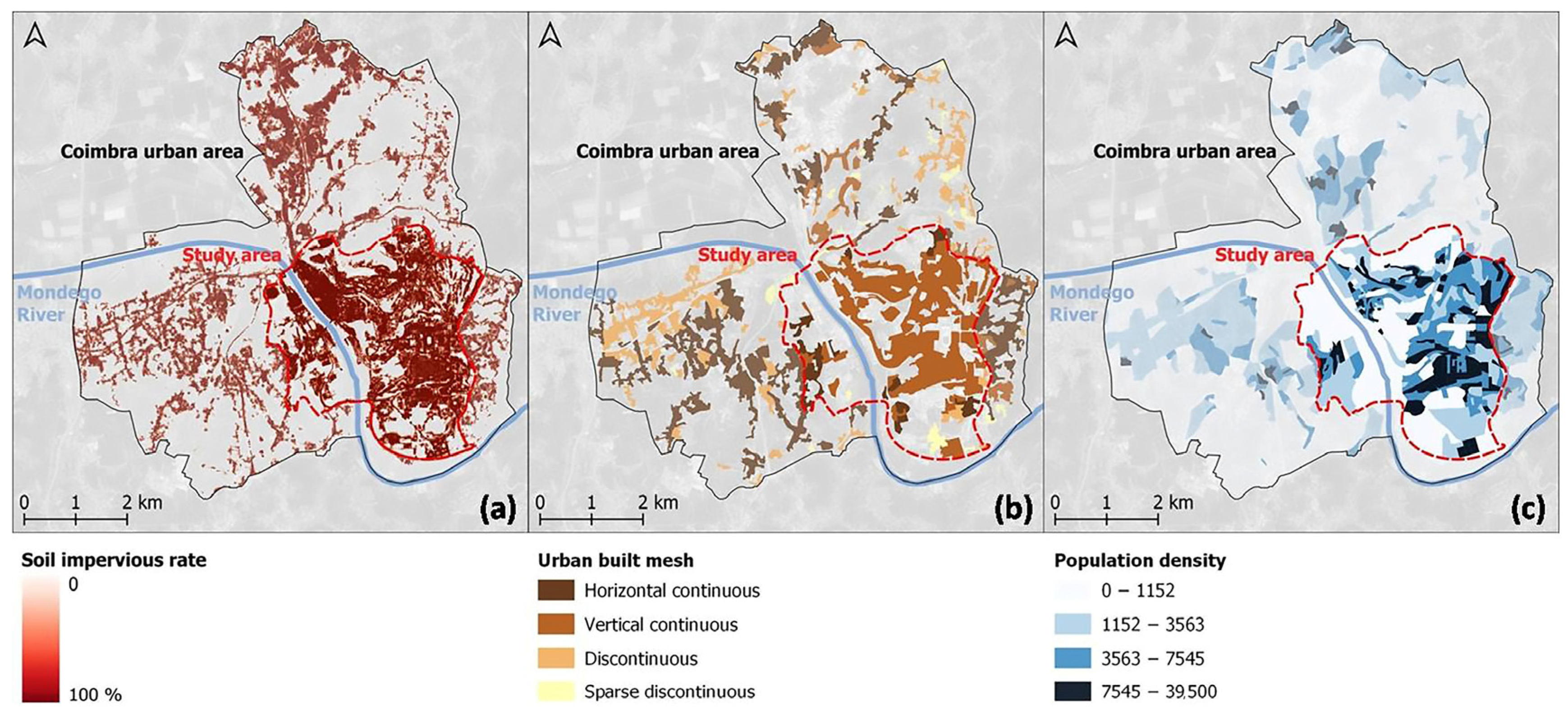
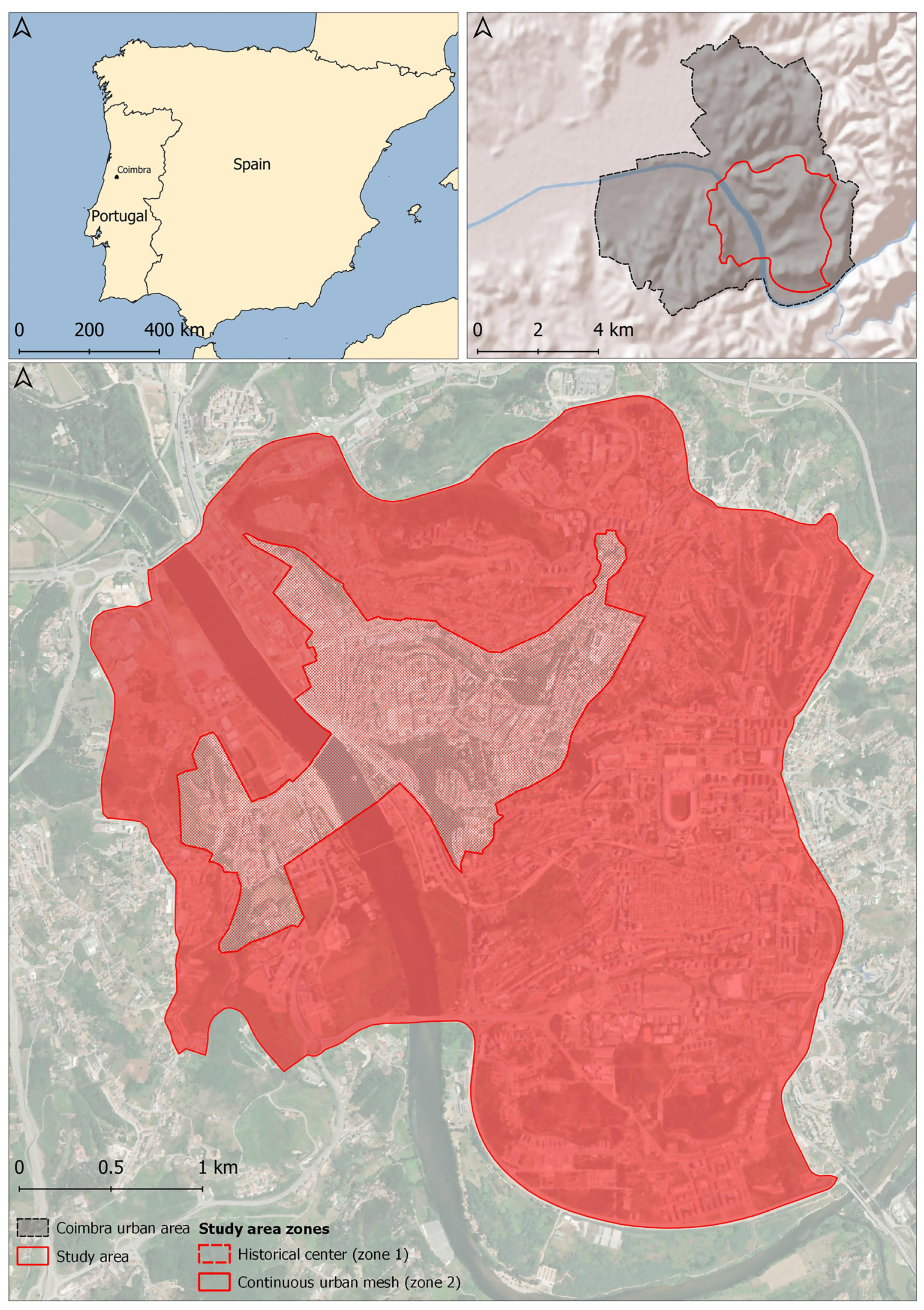
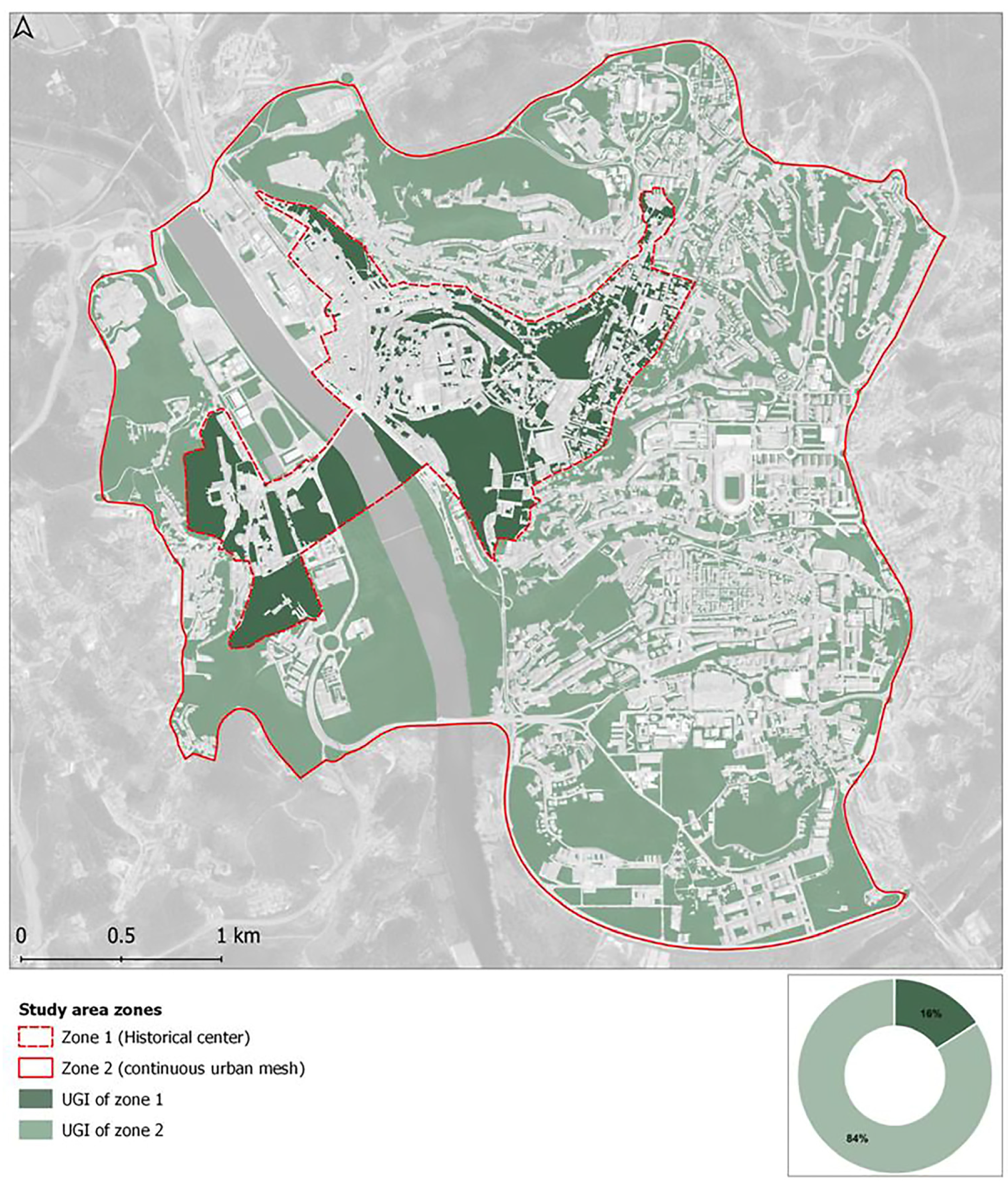


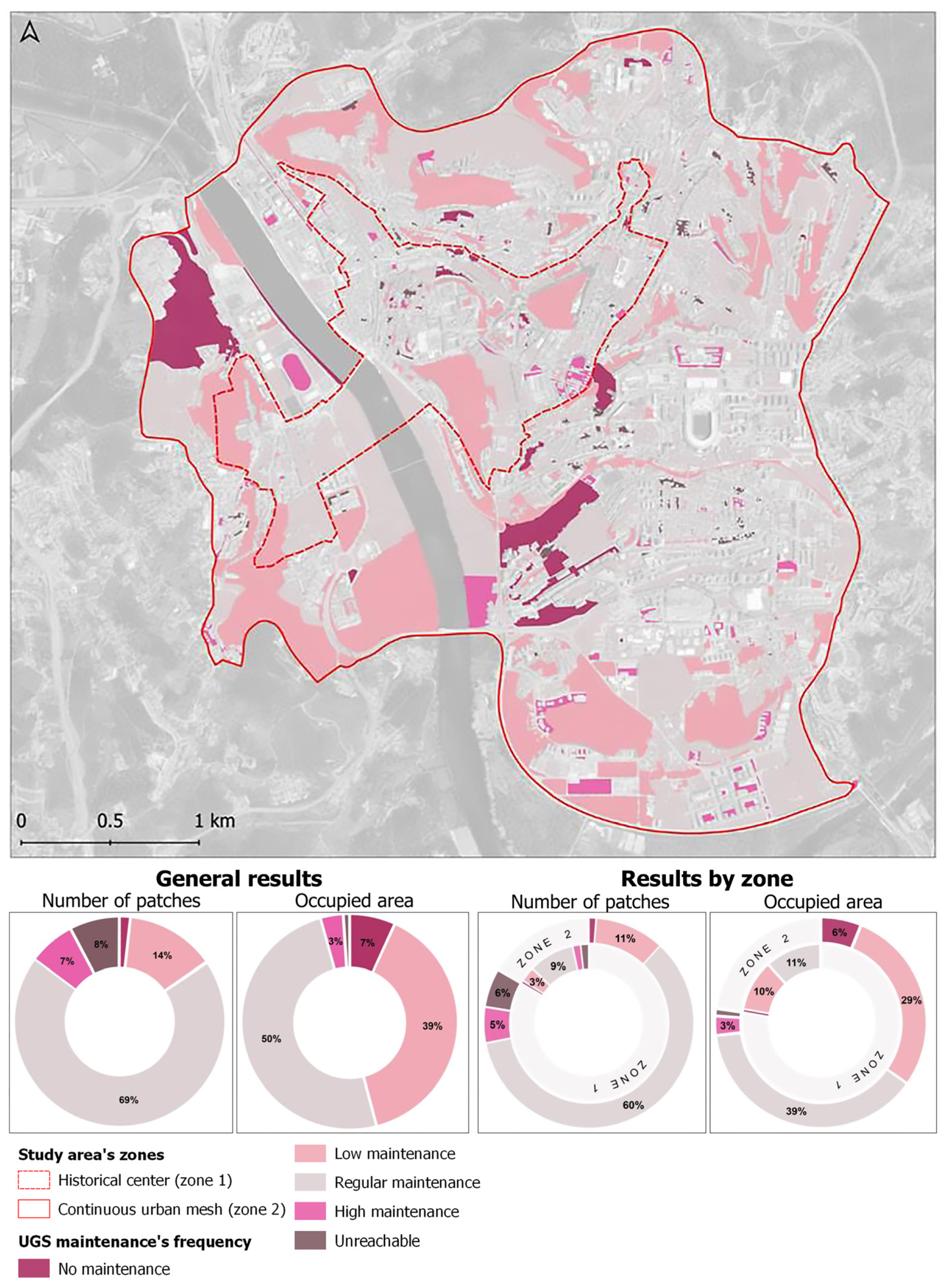
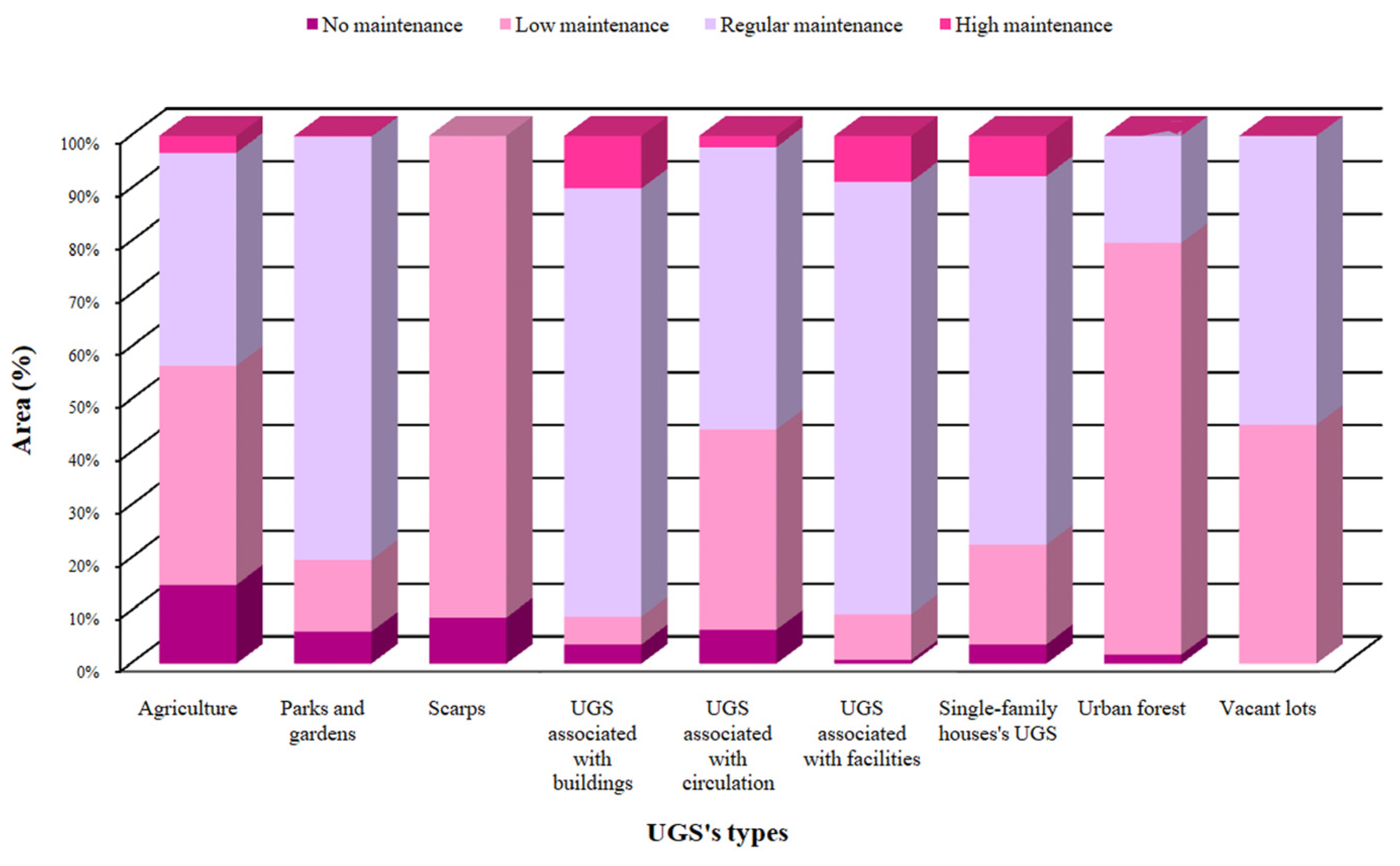

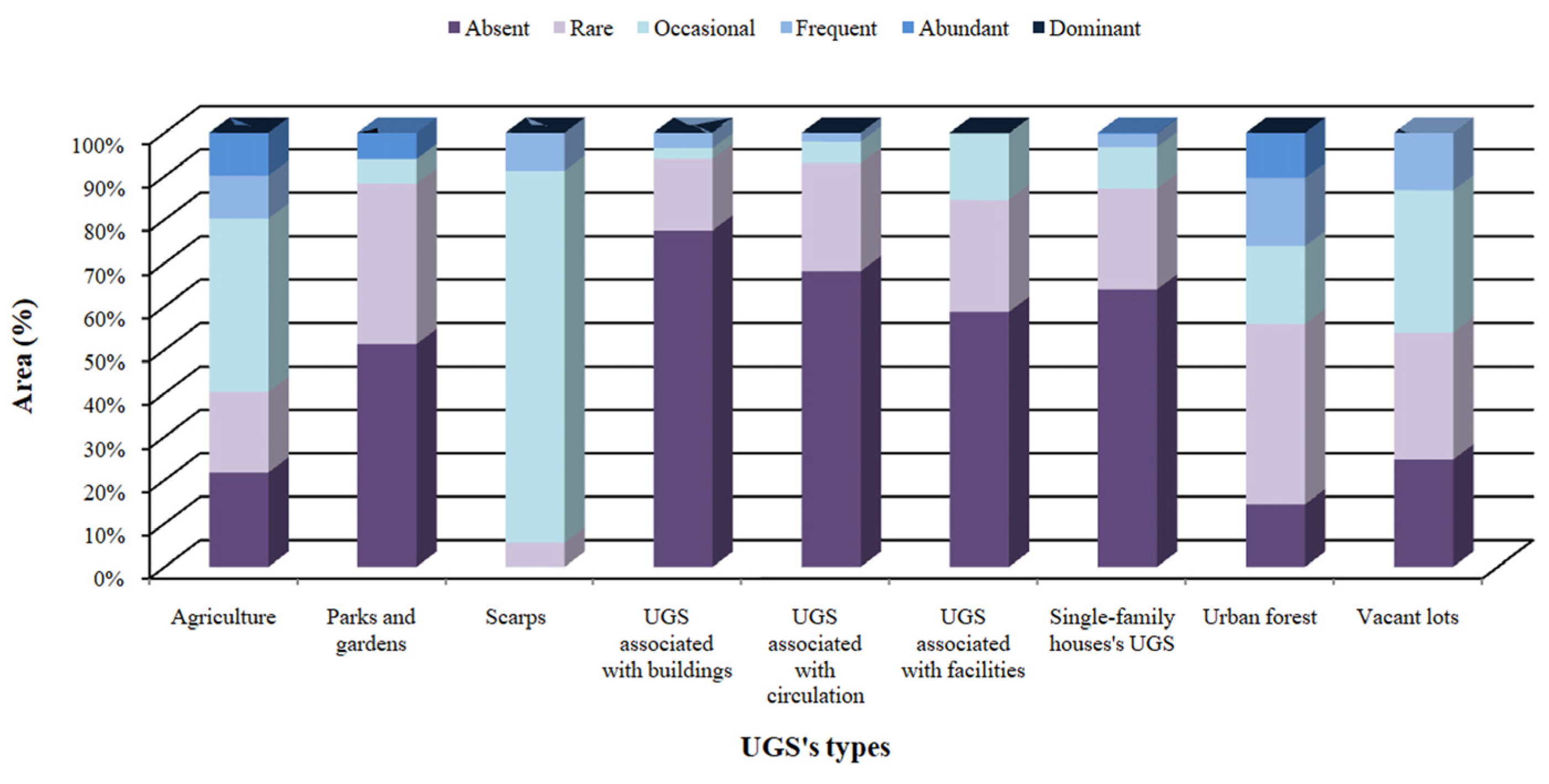

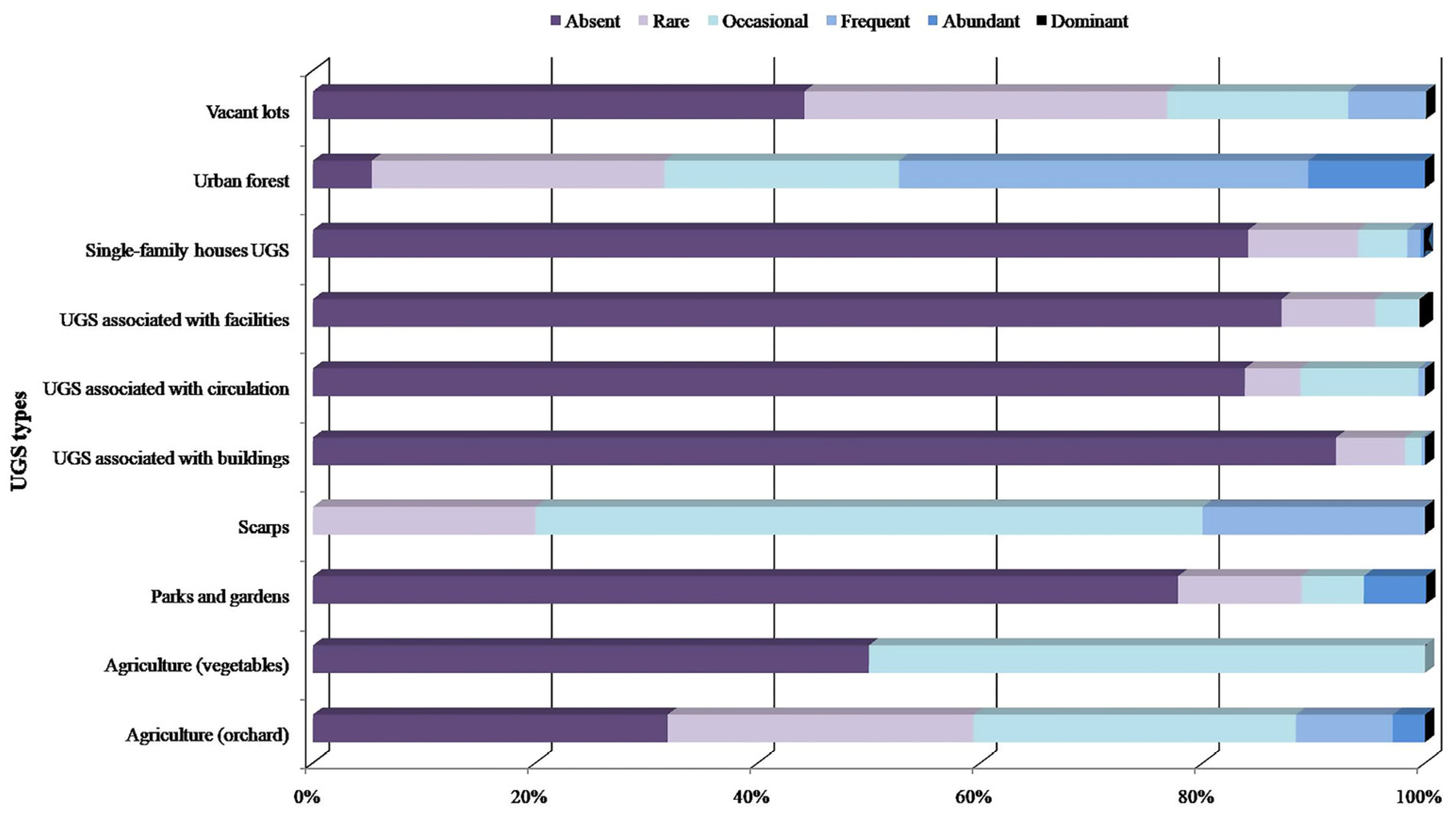
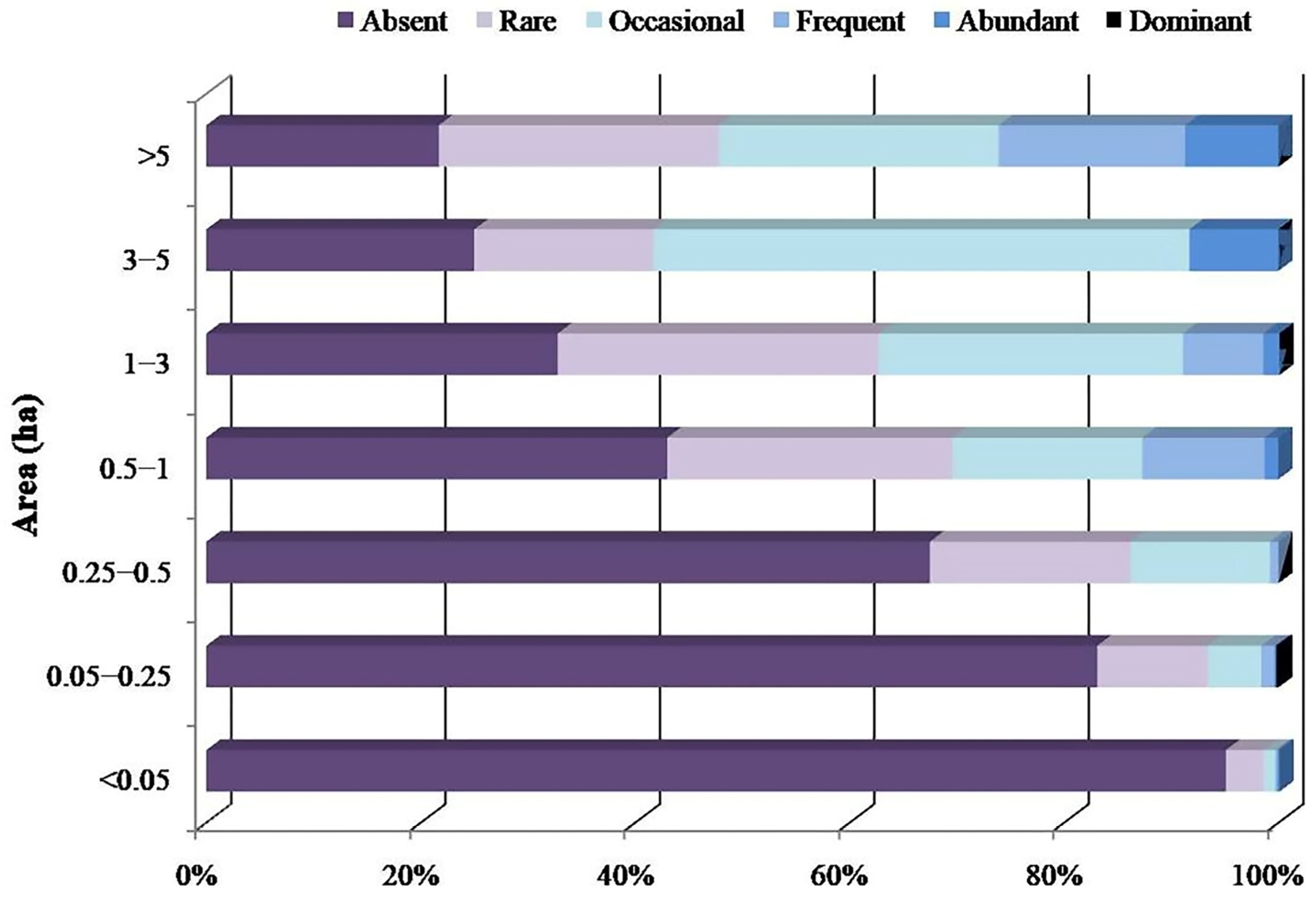
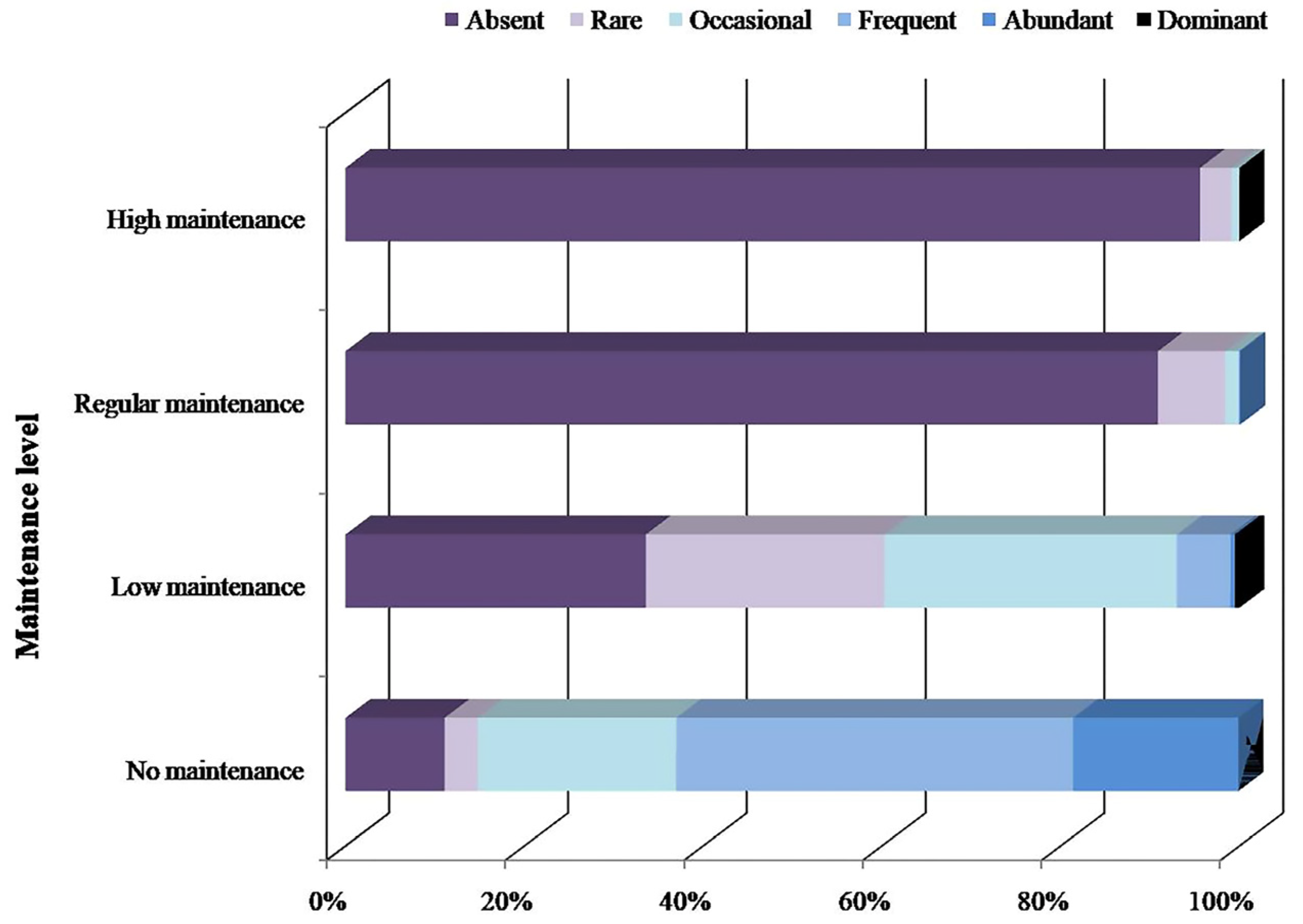
| Number | Name | Description |
|---|---|---|
| Classification of urban green spaces by type (adapted from [59]) | ||
| 1 | Agriculture | Agricultural use, for example, crops, orchards, or vineyards. |
| 2 | Parks and gardens | Designed space with paths and facilities (benches and toilets), dominated by vegetation (tree patches and shrubs, flowerbeds, lawns), and dedicated to direct public use. |
| 3 | Scarps | Areas with a slope equal to or greater than 45°. Generally with rocky outcrops and herbaceous and scattered woody vegetation with no signs of recent cultivation. Usually heterogeneous in texture and color. |
| 4 | Tree-lined streets | UGSs associated with circulation (avenues and streets) that have a tree layer in a tree pit or continuous green strip, in alignment. |
| 5 | UGS associated with buildings | Outdoor spaces associated with multi-family housing, such as social neighborhoods and urbanizations. |
| 6 | UGS associated with circulation | Green verges alongside railways, roads, or motorways. Examples of these areas are lateral green areas, nodes, and central strips. Garden areas of single-family or collective housing and tree-lined streets are excluded from this type. |
| 7 | UGS associated with facilities | Outdoor spaces with vegetation located around public buildings or with public services such as schools, hospitals, churches, universities, barracks, police stations, sports complexes, and public administrations (parish councils, municipal councils, etc.). |
| 8 | Single-family house UGS | Outdoor spaces associated with single-family housing, generally with private maintenance. |
| 9 | Urban forest | Outdoor spaces without spatial organization of plant structure and design, with significant forest-type tree cover with no signs of cultivation and paved paths. |
| 10 | Vacant lots | Unbuilt spaces, possibly surplus or abandoned, lack programmed function or explicit human use. They may result from the incomplete urbanization or abandonment of outdoor spaces associated with houses or farms. |
| Classification of urban green spaces by access to users (adapted from [60]) | ||
| 1 | Public | UGSs with free access. UGSs types include parks and gardens, tree-lined streets and UGSs associated with circulation. |
| 2 | Conditional | UGSs with restricted access. UGSs types include botanical gardens, urban forests, UGSs associated with facilities, and vacant lots. |
| 3 | Private | Private UGSs. UGSs types include UGSs associated with single-family houses, buildings, and agricultural areas. |
| Classification of urban green spaces by maintenance level | ||
| 0 | No maintenance | Evidence of neglect signs (e.g., obstructed drainage networks and disrepair pavements), with prevalence of spontaneous vegetation and unmanaged ornamental woody species grown. |
| 1 | Low maintenance | Display inadequate signs of maintenance, both in its structures (e.g., broken benches, non-functional lighting, pavements deterioration, and damaged drainage networks) and vegetation. Ornamental plants show signs of inadequate care (e.g., broken branches, dead plants, dry branches, and unnecessary supports) and spontaneous vegetation on built structures, circulation areas, and clearings. |
| 2 | Regular maintenance | Show adequate signs of maintenance (e.g., structures in good condition or regularly repaired with well- maintained pavements and drainage networks). Ornamental vegetation with minimal signs of degradation and occasional spontaneous vegetation with limited spatial expression. |
| 3 | High maintenance | Present structures, pavements, and drainage networks in excellent condition. Presence of ornamental vegetation with high maintenance requirements: lawns with frequent watering and mowing, seasonal plants replaced seasonally (4x year), trees and shrubs in good phytosanitary conditions, and cut hedges. Absence of spontaneous vegetation. |
| Scale of occurrence for invasive plant species | ||
| 0 | Absent | No invasive species were identified in the UGS. |
| 1 | Rare | Sparse individuals. |
| 2 | Occasional | Patches that occupy up to 25% of the area. |
| 3 | Frequent | Patches that occupy 25% to 50% of the area. |
| 4 | Abundant | Patches that occupy 50% to 75% of the area. |
| 5 | Dominant | Large patches that occupy more than 75% of the area. |
Disclaimer/Publisher’s Note: The statements, opinions and data contained in all publications are solely those of the individual author(s) and contributor(s) and not of MDPI and/or the editor(s). MDPI and/or the editor(s) disclaim responsibility for any injury to people or property resulting from any ideas, methods, instructions or products referred to in the content. |
© 2025 by the authors. Licensee MDPI, Basel, Switzerland. This article is an open access article distributed under the terms and conditions of the Creative Commons Attribution (CC BY) license (https://creativecommons.org/licenses/by/4.0/).
Share and Cite
Andrade, M.; Fernandes, C.; Figueiredo, A. Are Urban Green Spaces’ Attributes Relevant to Explain the Occurrence of Invasive Species Within Urban Green Infrastructure? Urban Sci. 2025, 9, 260. https://doi.org/10.3390/urbansci9070260
Andrade M, Fernandes C, Figueiredo A. Are Urban Green Spaces’ Attributes Relevant to Explain the Occurrence of Invasive Species Within Urban Green Infrastructure? Urban Science. 2025; 9(7):260. https://doi.org/10.3390/urbansci9070260
Chicago/Turabian StyleAndrade, Mónica, Cláudia Fernandes, and Albano Figueiredo. 2025. "Are Urban Green Spaces’ Attributes Relevant to Explain the Occurrence of Invasive Species Within Urban Green Infrastructure?" Urban Science 9, no. 7: 260. https://doi.org/10.3390/urbansci9070260
APA StyleAndrade, M., Fernandes, C., & Figueiredo, A. (2025). Are Urban Green Spaces’ Attributes Relevant to Explain the Occurrence of Invasive Species Within Urban Green Infrastructure? Urban Science, 9(7), 260. https://doi.org/10.3390/urbansci9070260






